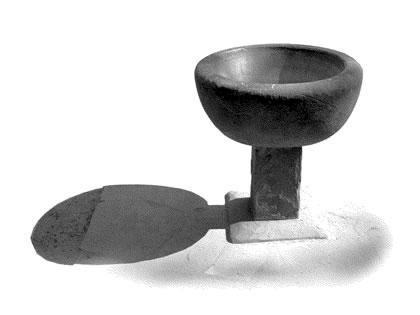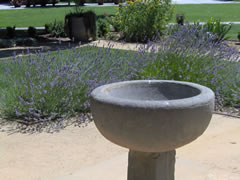Hardscape is the non-living functional elements of a garden such as paths, seating, and edging. Sustainable hardscape materials should come from recycled materials, be non-polluting, and, if possible, be produced locally to avoid excessive use of non-renewable energy sources such as petroleum and coal. Furthermore they should prevent soil erosion, water run-off, and last a long time before needing to be replaced.

Central basin in St. Clare Garden Photo by Edward Rooks © 2005

Granite Grinding Bowl
In the St. Clare Garden the following sustainable hardscape materials were used:
- Decomposed granite path fines allow water to percolate into the ground
- Edging boards along paths are made of a recycled sawdust building material
- Mortared flagstone salvaged from elsewhere on campus is used in places of heavy use to avoid water puddling and erosion
- High-quality durable wood benches and wooden arbors will last many years and don’t need to be varnished or painted
- Large concrete pots are durable and prevent the trees they are containing from getting too big
The central feature of the garden, a granite grinding bowl, is an example of recycled hardscape; it was made by local Ohlone Indians during the Mission Period (ca. 1775-1830).
This web site was written and designed by Nancy Lucid whose research was supported by a generous grant from the Bannan Institute for Jesuit Educational Mission at Santa Clara University.
For questions regarding the web site contact Nancy Lucid. All rights reserved.